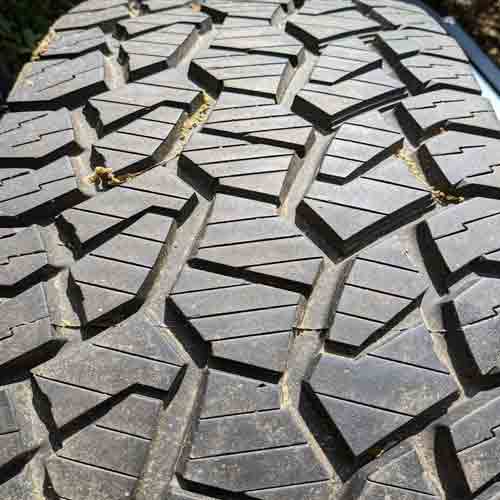Meet the Pathfinder AT, a tire that sets new standards in all-terrain performance. Designed for both on and off-road adventures, it offers the reliability and ruggedness essential for today’s driving experiences. Let’s explore what makes this tire, a standout choice for drivers.

Table of Contents
Key Takeaway
The Pathfinder AT excels in:
- Pavement Performance: Good steering response, grip, and stability on highways, with effective handling.
- Wet Traction: Excellent grip in wet conditions, aided by flexible interlocking sipes and a softer rubber composition.
- Fuel Efficiency: Efficient fuel usage due to lightweight structure and longitudinal lug arrangement.
- Ride Comfort: Softer rubber composition allows for good impact comfort, along with a quieter ride, (compared to its direct competitors).
Areas for Improvement:
- Tread Mileage: Faster wear rate due to smaller tread depth.
- Snow Performance: Limited effectiveness in extreme cold and on icy surfaces, lacking a 3-Peak Mountain Snowflake certification.
- Off-Road Capability: Struggles in mud, dirt, and gravel due to quick dirt buildup and ineffective mud expulsion.
- Wet Grip Enhancements: Needs better tread design to improve hydroplaning resistance, particularly.
Available Tire Sizes
The Pathfinder AT comes in 15 to 20 inches wheels/rims, with following specs.
- Speed ratings: S and T.
- Load ratings: XL, C and E only.
- Tread depth range: 12/32″ on all.
- UTQG: 500 AB.
- Treadwear warranty: 55k miles (for non LT sizes).
PS. LT tires have outlined white letters.
Tread Design
Discussing the tread pattern, let us focus on its central part first, where you’d find three principal ribs characterized by their distinct blocks.

Considering the central most rib, the “Z-shaped” blocks are closely packed, a result of the narrow lateral grooves they form.
This design is primarily aimed at improving directional grip on paved surfaces, a function further enhanced by the reinforced foundations under the lugs.
As we move outward, the lugs around the central ribs display a more open design.
These lugs not only have interlocking sipes and chamfered edges but also feature biters oriented towards the tire’s shoulders.
Speaking of which, the shoulder lugs share similar attributes (compared to central lugs), in terms of notches and sipes, they do not exhibit the aggressive structure typically found on all-terrain tires.
I mean they are very on-road oriented, as they are not staggered, and have ridges placed in between. And yes, the sidewall lugs aren’t thick enough too (primarily for flexing, with lowered air pressure).
Quick Heads-Up: Not sure which all-terrain tires to pick? No worries, start here: https://tiredriver.com/all-terrain-tires/
Pavement Performance Analysis
Highways require a tire capable of maintaining a robust and steady connection with the road to guarantee a seamless and effective performance.
However, the aggressive tread patterns characteristic of off-road tires often necessitate certain compromises in this domain.
Despite this, the Pathfinder AT impresses considerably, providing satisfactory steering response, grip, and lateral stability, as you’d see below.
Grip
Grip, complemented by adept handling, stands as a cornerstone in assessing a tire’s total traction.
Where the grip (often called directional grip), depends on the central tread area (of the tread), whereas the shoulders are judged when it comes to handling.
Basically the central area gets the most weight distribution as the tire rolls straight, so it makes sense why the Pathfinder AT, with its wide middle-most rib featuring Z-shaped lugs, delivers good enough enough braking performance by offering a pretty short braking distance values (as seen on tests).
Note: While the tire performs well, there’s still a potential for further improvement, where the tire could use a lighter internal construction. This change would reduce the tire’s momentum inertia, making it easier to bring the vehicle to a stop. Essentially, a lighter tire would require less force to decelerate, enhancing its stopping efficiency.
Handling
The PathFinder AT’s handling performance is also pretty commendable, as its shoulder lugs are interconnected with each other (longitudinally).
This basically resists the excessive flexing of the lugs as the tire corners, whilst offering ample rubber to road contact.
And yes, here the relatively smaller weight of the tire also helps, which puts less pressure on those shoulder lugs, keeping inertia to a limit.
This basically provides you with a pretty good balance between under and over steering, so you get good enough steering response.
Wet Performance
A tire’s ability to maintain good traction on wet surfaces is largely dependent on its effectiveness in shedding water from its tread.
This function is performed by two primary features in the tread: grooves, which help in preventing hydroplaning, and sipes that contribute to enhancing wet grip.
Let’s take a closer look at both these components.
Wet Grip
Sipes are basically tiny slits or gaps in the tire tread that hold air. And when these slits come in contact with the road, they release this air, creating a suction effect that quickly absorbs water.
So this brings us to two important observations:
- More sipes mean better wet traction.
- And the sipes need to be flexible enough to create sufficient suction.
Now having said that, in comparison to other all-terrain tires in its budget category, the Pathfinder AT showcases slightly better abilities to grip wet surfaces.
This is thanks to its flexible interlocking sipes, which remain adaptable even during sharp turns and sudden brakes, a trait further enhanced by its softer rubber composition.
Hydroplaning Resistance
Hydroplaning happens when a tire fails to displace water quickly enough through its grooves, leading to the tire “floating” or forming a thin layer of water between the tire and the road.
So needless to say, you lose all traction when this happens.
But this isn’t a concern with most all-terrain tires including the Pathfinder AT, which possesses a tread structure with enough voids to prevent hydroplaning.
I mean its well-connected lateral and longitudinal tread voids, ensuring safe driving on watery surfaces, where you get to see decent float speeds.
For Your Info: Float speed is the exact speed at which the tire loses contact with the ground, with water coming in the way. It’s measured on a few millimeters deep water covered surface, with the help of cameras and sensors.
Fuel Efficiency
Fuel efficiency is contingent upon a couple of factors that influence the rolling resistance a tire generates.
So here, striking the right balance is crucial, I mean excessive resistance can escalate fuel consumption, while too little might sacrifice grip and stability.
Now the Pathfinder AT exemplifies optimal balance here, merging both aspects.
Despite its lightweight structure, the longitudinal arrangement of its lugs facilitates superior directional rolling. And this intricate design enables the tire to utilize less fuel compared to its counterparts.
Furthermore, the Pathfinder AT stands out due to its modest tread depth, which is somewhat lesser compared to other A/T tires on average.
This characteristic not only improves the tire’s responsiveness but also minimizes the susceptibility of its lugs to excessive flexing.
Why does this matter, you ask?
The significance lies in energy conservation.
So with minimized rubber flexing, more energy is channeled into the tire’s rolling, enhancing efficiency and performance, (and less is used in tread molding).
Tread Mileage
The lifespan of a tire is intricately tied to its material composition and tread depth.
Now even though the Pathfinder AT comes with a relatively harder rubber compound, it still gets to burn faster, and it’s lower tread depth reaches down to the 2/32″ faster, which is the legal limit.
And the culprit here is the tire’s smaller tread depth.
I mean where most of the A/T tires have an average tread depth of above 15/32″, this tire only offers 12/32″.
For Your Info: Curious about the best all-terrain tire for tread life? The Grabber ATX takes the top spot, which is why I’ve included it in my list of the best A/T options. Check it out here: https://tiredriver.com/best-all-terrain-tires/
Snow Performance
Tackling winter conditions demands a tire equipped to handle a variety of terrain challenges, where ice is the most difficult one.
Basically on ice, you need a multitude of biting edges, (whereas on deep snow requiring significant tread voids, which most of the A/T tires have).
Having said that, the Pathfinder AT manages to put up a decent show despite not having the 3-Peak Mountain Snowflake certification.
It comes equipped with a good number of notches dispersed across the tread, which assist in securing grip on snowy surfaces by forming snow to snow contact.
(Its significant, as snow sticks on snow better compared to rubber).
But one thing to note is that, the tire isn’t able to retain its flexibility when it comes to extremely low temperatures, as it does not offer a good enough thermally adaptive tread.
Ride Comfort
Comfort of the tire is largely influenced by its efficacy in negating road irregularities, (a trait governed by its composition and tread pattern).
In this regard, the Pathfinder AT performance is noteworthy and appreciable.
Simply put, its construction includes a next-generation tread compound and a pliant rubber material, enabling it to effectively absorb most road vibrations.
Moreover, it also offers a very quite on road ride, which is another major factor in overall comfort.
Now noise is produced when air particles hit the tread walls, and Pathfinder with its compact design, inhibits the infiltration of air particles, in the first place.
Moreover, it also uses advanced pitch sequencing technology, where lugs get to have slightly varied geometry, so air particles hitting them produce a range of frequencies, which then try to cancel out each other.
Mud, Dirt, and Gravel Performance
When it comes to performance on surfaces like dirt and gravel, the Pathfinder AT does a decent job, providing good enough traction (let’s just put it at that).
However, it misses out on strong stone ejectors, making it prone to quick dirt buildup which can affect traction and potentially harm the tread.
This issue extends to muddy terrains predominately, where the tire easily gets packed up with the thick mud/clay.
Basically the tire’s closely arranged shoulder design restricts mud from being expelled effectively, and its continuous middle ribs don’t offer adequate pathway for mud to exit out (in time), resulting in easy clogging.
Moreover, the lack of mud scoops, and staggered shoulder lugs, limits the traction even further (as these scoops create forward momentum by throwing the mud backwards).
Though the tire isn’t all bad, I mean its lugs have reinforced foundations and that help to some extent in ejecting dirt. And yes, it also offers a chip resistant rubber, and a durable enough internal construction, which can handle lighter gravely roads with ease.
Rocky Terrain Traction
When it comes to navigating rocky terrains, a tire needs to have a sturdy internal build coupled with numerous biting edges for optimum grip. And unfortunately, this is an area where the Pathfinder AT falls short.
Although the tire incorporates a few gripping edges in its tread pattern, its sidewalls are a weak link, where they barely make any lugs.
And yes, with only 2 ply sidewalls construction, you can get these tires punctured pretty easily, (on aggressive terrains).
Moreover, with thin sidewalls, and the lack of staggered shoulder blocks, the overall rock climbing grip is significantly hindered, where lowering the air pressure also does not help a lot.
Take Home Points
The Pathfinder AT tire exhibits a mixed performance across different terrains.
It offers a pretty quiet ride, thanks to its variable pitch technology, and it maintains a decent grip on snowy and wet surfaces. And yes, it also does pretty well when it comes to fuel consumption.
Moreover, it also performs decent, in terms of bumps absorption comfort, but can use some help in terms of tread life.
Furthermore, its performance on rough and rocky terrains is also not the strongest due to its limited sidewall construction and vulnerability to clogging in muddy conditions.